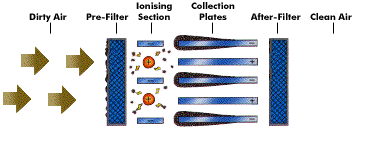ELECTRONIC STATIC PRECIPITATOR AND MECHANCIAL FILTRATION (HEPA FILTERS)

ELECTRONIC STATIC PRECIPITATOR
An electrostatic precipitator (ESP) is a filtration device that removes fine particles, like dust and smoke, from a flowing gas using the force of an induced electrostatic charge minimally impeding the flow of gases through the unit.
How Electrostatic Precipitators Work
Air is drawn into the unit to capture particles. The airborne particles pass through an electrostatic field and receive an ionized charge. The charged particles move into a collector section where each alternate plate is charged with the same polarity as the particles. This drives the particles to the second set of plates of an opposite charge to attract and collect the particles. The cleaned air is then returned to the plant or building.

Unlike media air cleaners that use replaceable filters that plug up when dirty, electrostatic precipitators contain permanent cells that can be washed, either manually or with an included automatic wash system. These permanent cells do not require added static pressure when they get dirty to pull air through them. This typically means motors are 1 to 2 sizes smaller, saving the operator energy costs, as well as the cost to dispose of dirty filters
BENEFITS:
- Specially designed self draining pre filter for minimising load on ESP section and thus maximising cleaning frequency of the cleaning cells of the ESP.
- Safety feature of automatic switching off power supply in case of door getting open.
- Very compact unit due to which it occupies very little ground space.


